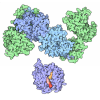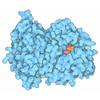+ Open data
Open data
- Basic information
Basic information
| Entry | Database: PDB / ID: 6mix | ||||||
|---|---|---|---|---|---|---|---|
| Title | Human TRPM2 ion channel in apo state | ||||||
 Components Components | Transient receptor potential cation channel subfamily M member 2 | ||||||
 Keywords Keywords | MEMBRANE PROTEIN / Channel / TRPM2 / TRP / ADPR / ADP-ribose / NUDT9H / NUDT9 / calcium / ion channel | ||||||
| Function / homology |  Function and homology information Function and homology informationmono-ADP-D-ribose binding / manganese ion transmembrane transporter activity / ligand-gated calcium channel activity / dendritic cell differentiation / zinc ion transmembrane transport / response to purine-containing compound / cellular response to temperature stimulus / regulation of filopodium assembly / response to hydroperoxide / dendritic cell chemotaxis ...mono-ADP-D-ribose binding / manganese ion transmembrane transporter activity / ligand-gated calcium channel activity / dendritic cell differentiation / zinc ion transmembrane transport / response to purine-containing compound / cellular response to temperature stimulus / regulation of filopodium assembly / response to hydroperoxide / dendritic cell chemotaxis / TRP channels / calcium ion transmembrane import into cytosol / temperature homeostasis / sodium channel activity / intracellularly gated calcium channel activity / calcium ion import across plasma membrane / tertiary granule membrane / ficolin-1-rich granule membrane / specific granule membrane / monoatomic cation channel activity / release of sequestered calcium ion into cytosol / cellular response to calcium ion / cytoplasmic vesicle membrane / regulation of actin cytoskeleton organization / cell projection / calcium ion transmembrane transport / calcium channel activity / cellular response to hydrogen peroxide / calcium ion transport / response to heat / protein homotetramerization / perikaryon / lysosome / lysosomal membrane / calcium ion binding / Neutrophil degranulation / plasma membrane Similarity search - Function | ||||||
| Biological species |  Homo sapiens (human) Homo sapiens (human) | ||||||
| Method | ELECTRON MICROSCOPY / single particle reconstruction / cryo EM / Resolution: 3.6 Å | ||||||
 Authors Authors | Wang, L. / Fu, T.M. / Xia, S. / Wu, H. | ||||||
 Citation Citation |  Journal: Science / Year: 2018 Journal: Science / Year: 2018Title: Structures and gating mechanism of human TRPM2. Authors: Longfei Wang / Tian-Min Fu / Yiming Zhou / Shiyu Xia / Anna Greka / Hao Wu /  Abstract: Transient receptor potential (TRP) melastatin 2 (TRPM2) is a cation channel associated with numerous diseases. It has a C-terminal NUDT9 homology (NUDT9H) domain responsible for binding adenosine ...Transient receptor potential (TRP) melastatin 2 (TRPM2) is a cation channel associated with numerous diseases. It has a C-terminal NUDT9 homology (NUDT9H) domain responsible for binding adenosine diphosphate (ADP)-ribose (ADPR), and both ADPR and calcium (Ca) are required for TRPM2 activation. Here we report cryo-electron microscopy structures of human TRPM2 alone, with ADPR, and with ADPR and Ca NUDT9H forms both intra- and intersubunit interactions with the N-terminal TRPM homology region (MHR1/2/3) in the apo state but undergoes conformational changes upon ADPR binding, resulting in rotation of MHR1/2 and disruption of the intersubunit interaction. The binding of Ca further engages transmembrane helices and the conserved TRP helix to cause conformational changes at the MHR arm and the lower gating pore to potentiate channel opening. These findings explain the molecular mechanism of concerted TRPM2 gating by ADPR and Ca and provide insights into the gating mechanism of other TRP channels. | ||||||
| History |
|
- Structure visualization
Structure visualization
| Movie |
 Movie viewer Movie viewer |
|---|---|
| Structure viewer | Molecule:  Molmil Molmil Jmol/JSmol Jmol/JSmol |
- Downloads & links
Downloads & links
- Download
Download
| PDBx/mmCIF format |  6mix.cif.gz 6mix.cif.gz | 937.8 KB | Display |  PDBx/mmCIF format PDBx/mmCIF format |
|---|---|---|---|---|
| PDB format |  pdb6mix.ent.gz pdb6mix.ent.gz | 773.5 KB | Display |  PDB format PDB format |
| PDBx/mmJSON format |  6mix.json.gz 6mix.json.gz | Tree view |  PDBx/mmJSON format PDBx/mmJSON format | |
| Others |  Other downloads Other downloads |
-Validation report
| Summary document |  6mix_validation.pdf.gz 6mix_validation.pdf.gz | 1.1 MB | Display |  wwPDB validaton report wwPDB validaton report |
|---|---|---|---|---|
| Full document |  6mix_full_validation.pdf.gz 6mix_full_validation.pdf.gz | 1.1 MB | Display | |
| Data in XML |  6mix_validation.xml.gz 6mix_validation.xml.gz | 132.2 KB | Display | |
| Data in CIF |  6mix_validation.cif.gz 6mix_validation.cif.gz | 206.7 KB | Display | |
| Arichive directory |  https://data.pdbj.org/pub/pdb/validation_reports/mi/6mix https://data.pdbj.org/pub/pdb/validation_reports/mi/6mix ftp://data.pdbj.org/pub/pdb/validation_reports/mi/6mix ftp://data.pdbj.org/pub/pdb/validation_reports/mi/6mix | HTTPS FTP |
-Related structure data
| Related structure data |  9132MC  9133C  9134C  6mizC  6mj2C M: map data used to model this data C: citing same article ( |
|---|---|
| Similar structure data |
- Links
Links
- Assembly
Assembly
| Deposited unit | 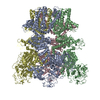
|
|---|---|
| 1 |
|
- Components
Components
| #1: Protein | Mass: 171416.188 Da / Num. of mol.: 4 Source method: isolated from a genetically manipulated source Source: (gene. exp.)  Homo sapiens (human) / Gene: TRPM2, EREG1, KNP3, LTRPC2, TRPC7 / Production host: Homo sapiens (human) / Gene: TRPM2, EREG1, KNP3, LTRPC2, TRPC7 / Production host:  Homo sapiens (human) / References: UniProt: O94759 Homo sapiens (human) / References: UniProt: O94759Has protein modification | Y | |
|---|
-Experimental details
-Experiment
| Experiment | Method: ELECTRON MICROSCOPY |
|---|---|
| EM experiment | Aggregation state: PARTICLE / 3D reconstruction method: single particle reconstruction |
- Sample preparation
Sample preparation
| Component | Name: Human TRPM2 ion channel / Type: COMPLEX / Entity ID: all / Source: RECOMBINANT |
|---|---|
| Source (natural) | Organism:  Homo sapiens (human) Homo sapiens (human) |
| Source (recombinant) | Organism:  Homo sapiens (human) Homo sapiens (human) |
| Buffer solution | pH: 7.4 |
| Specimen | Conc.: 1 mg/ml / Embedding applied: NO / Shadowing applied: NO / Staining applied: NO / Vitrification applied: YES |
| Specimen support | Details: unspecified |
| Vitrification | Cryogen name: ETHANE |
- Electron microscopy imaging
Electron microscopy imaging
| Experimental equipment |  Model: Titan Krios / Image courtesy: FEI Company |
|---|---|
| Microscopy | Model: FEI TITAN KRIOS |
| Electron gun | Electron source:  FIELD EMISSION GUN / Accelerating voltage: 300 kV / Illumination mode: FLOOD BEAM FIELD EMISSION GUN / Accelerating voltage: 300 kV / Illumination mode: FLOOD BEAM |
| Electron lens | Mode: BRIGHT FIELD |
| Image recording | Electron dose: 70.12 e/Å2 / Detector mode: COUNTING / Film or detector model: GATAN K2 SUMMIT (4k x 4k) |
- Processing
Processing
| Software | Name: PHENIX / Version: 1.14_3260: / Classification: refinement |
|---|---|
| CTF correction | Type: NONE |
| 3D reconstruction | Resolution: 3.6 Å / Resolution method: FSC 0.143 CUT-OFF / Num. of particles: 34477 / Symmetry type: POINT |
 Movie
Movie Controller
Controller



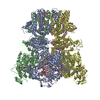
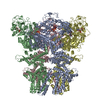
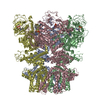

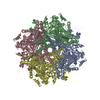
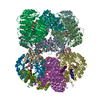
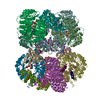


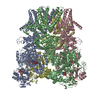
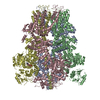
 PDBj
PDBj